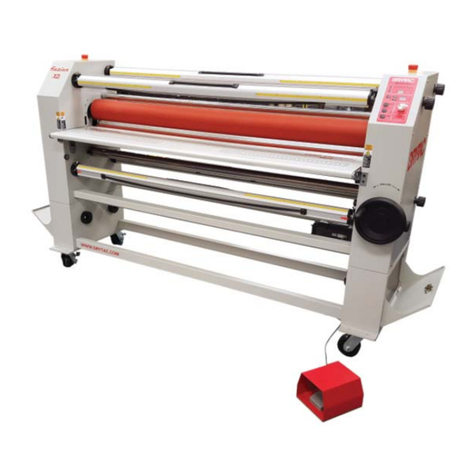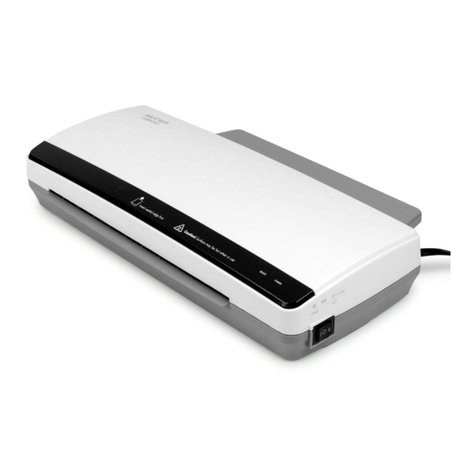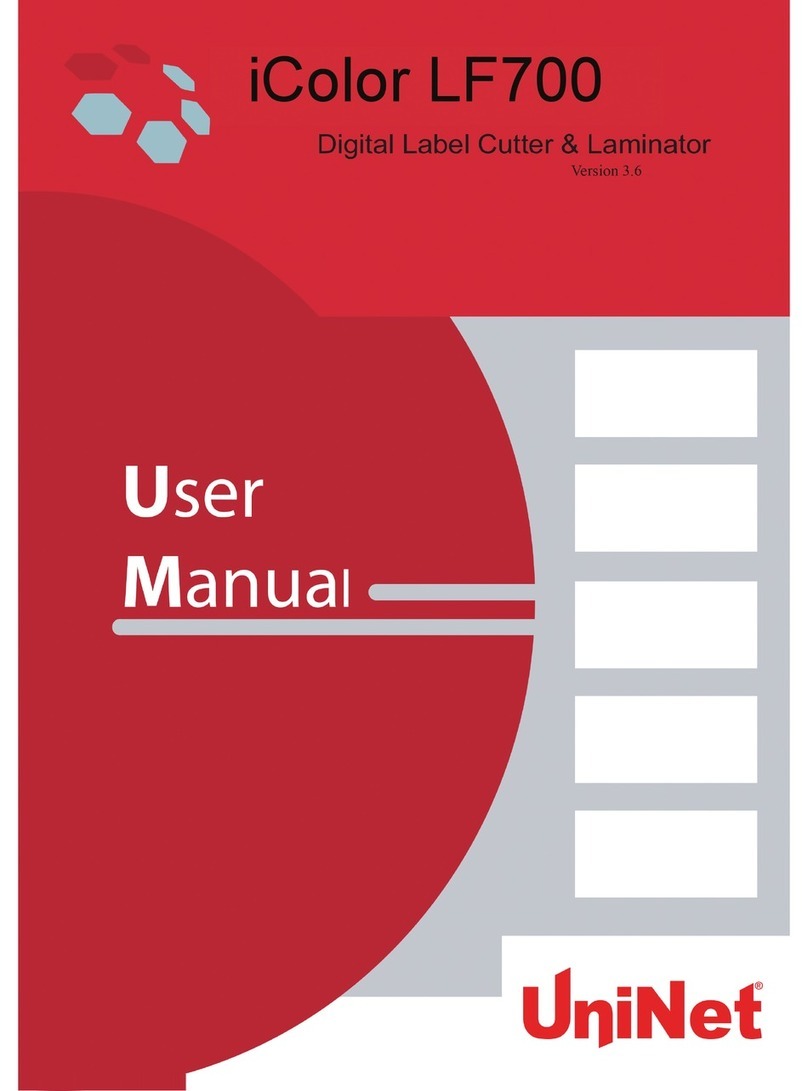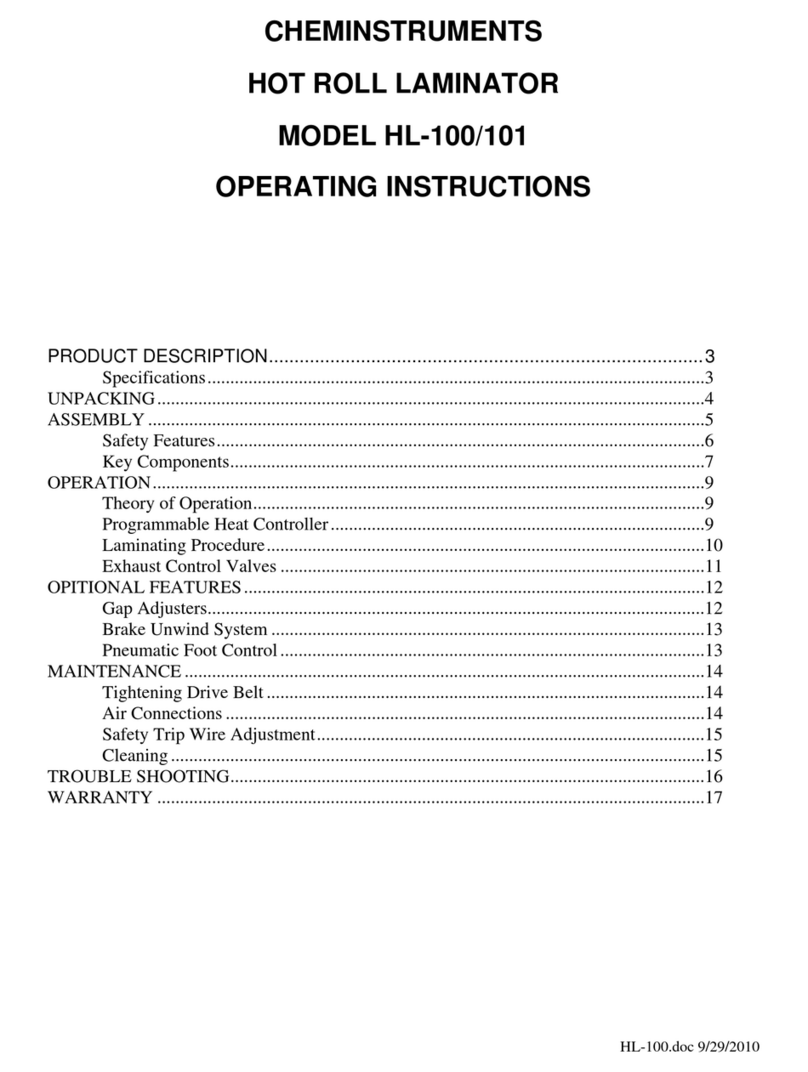Rollover FLEXI User manual

1
User Manual

2
Table of content
General information page 3
Overview page 3
Warning symbols/safety instructions page 4-5
Installation & assembly page 5
Emergency Stop Switch page 5
Delivery inspection page 6
Transport Wire Locks page 6
Air connection page 7
Controls page 8
Dismounting of the roller gantry page 9
Lifting Instructions page 9
Operation and application page 10-11
Maintenance and adjustments page 11-12
Troubleshooting page 13
Repairs page 13

3
Congratulations!
You have invested in a Rollover Flatbed Applicator enabling you to do various applications very
efficiently and with excellent quality, as well as serving as a very versatile work station.
Rollover Flatbed Applicators are very easy to operate and maintain, but you should still take the time to
read through this manual carefully. By doing this, you can exploit your Rollover in the optimal way and
at the same time you will reduce the possibility for operator- or machine damages. Please also check out
www.rollover.no including our YouTube Channel revealing numerous videos on the use of the machine.
General information
The Rollover Flatbed Applicator is built for application of printed vinyl, application tape, laminates and
all types of self-adhesive film (i.e. plotter text and digital print) on all types of flat substrates i.e. metal,
plastic, glass, foam boards, banners etc. Rollover is designed for dry application of media and produces a
result completely free of bubbles and creases. The machine’s main structure includes an illuminated
glass bed comprising operation details and an antistatic rubber roller with pneumatic pressure manually
activated over the work surface.
Overview
A: Back-lit glass bed
B: Activation switch
C: Handle for sideways movements
D: Rubber Roller
E: Reversible brackets/spindle for media
F: Tool pocket

4
Warning symbols
Before you start using your Rollover Flatbed Applicator you should read this manual carefully. This will
give you the opportunity to handle the machine in the best possible way so you can avoid damages both
to the machine and operator.
See the Contact a Risk of crushing Electrical hazard
manual technician between roller and
glass bed
Safety
The pneumatic pressure of the roller against the table may cause crush injury. It is vital to be aware of
this when operating the Rollover, especially if there is more than one person involved in the process.
Personal safety equipment
Specific personal safety equipment is not required for normal use of the Rollover.
Testing, control and use of safety functions.
During installation, service and maintenance, the safety functions must be tested. This includes
functions such as emergency stop, power failure and loss of pressure. When trigging the emergency
stop switch and in the occurrence of power failure, the roller will automatically raise. If the pneumatic
pressure lapses, the roll will lower slowly and stop about 3 mm over the working surface. In this
situation there is no crushing hazard.

5
Location of the emergency stop switch:
The emergency stop button is located at the short end of the machine. When the switch is pressed in,
the roller will raise immediately.
Other risks
Certain risks cannot be eliminated through technical safety measures alone. There is a risk of crushing
and catching when the roller is pneumatically pressed against the flat bed. A warning symbol is
displayed on or immediately beside the roller. There is a risk of severe crushing and catching when the
roller is pneumatically pressed against the supporting bars. Never pressure-set the roller without first
ensuring that the sign material is positioned correctly underneath the roller.
Unauthorized use
The machine must only be used for its intended purpose as specified in this manual. All other use may
result in damage or injury, and is at the user’s own risk.
Installation & assembly
Rollover Flatbed Applicator should be assembled and used at normal room temperature with normal
humidity levels. This minimizes the occurrence of static electricity. Detailed instructions for mounting of
the roller/roller sliding arms is found in this binder.
Lifting instructions
The Rollover must be lifted with a forklift fitted with long forks. The forks must have a minimum length
of 7’, and a min. lifting capacity of 1000 kg. Upon arrival in the wooden crate, the pallet itself is the
reinforced lifting base, and the lifting positions are well marked. Once on the ground, unscrew the top
grid, remove with the forklift and loosen the machine from the pallet by removing the screws holding
each leg. When lifting the unit off the pallet for further transport or disassembly, the forks must be
positioned as indicated by the yellow stickers found on each of the long sides. It is very important that
the roller is close to the lifting point as well as fixed preventing it from sliding which potentially can
alter the point of gravity.

6
Delivery inspection
The following elements are included when the machine is delivered;
•Rollover Flatbed Applicator
•Cutting mat
•2 spindles for holding media
•2 reversible brackets for attaching the spindles on the housings/machine ends
•User Manual/instruction for dismounting/mounting of the roller gantry
•Power cord
Transport Wire Locks
These transport wire locks prevent the roller gantry from moving during transport. They are located
on each side of the Applicator and clearly marked with labels as shown above. Unscrew (Torx T30) and
remove both locks before attempting to move the roller gantry over the glass bed.

7
Air connection
Compressed Air is supplied through the quick-connector/gauge located at the short end of the
Applicator –this is where you also will find the CE-label, switches & controls –see above picture. During
operation: recommended 6 –6,5 bar air pressure, filtered and moisture free air –max pressure 8 bar.
The quick connector fixed to the gauge fits an air hose w/clamp coming from the compressor. If needed,
the connector can be unscrewed from the gauge to connect with a standard ¼’’ threaded connector of
your preference.
Power connection
230V AC 50Hz/120V AC 60Hz or adapted to the local standard
Power plug may only be connected to sockets with 230V AC/120V AC. All other interventions to
the electrical system may only be performed by authorized staff. For markets with deviating voltage, the
applicator will be adapted to local standard.
Access to internal air- and electrical connections
All internal connections for air and electricity is placed behind the cover at the short end of the table. To
access these, loosen the upper two screws and flip the cover outwards. It will stop in a horizontal
position, allowing for inspection or repair.

8
Controls:
Shown in the picture from the left hand side: Main switch, resettable fuse, power inlet, light switch,
reset switch (if emergency stop has been activated), emergency stop.
Behind the cover:
Main switch, fuse, power inlet, light switch, emergency stop, printed circuit board.

9
Flooring
Rollover Graphic Applicators must be placed on a flat, moisture-free and vibration free surface.
Dismounting/mounting of the roller gantry
1) Disconnect the quick-connector for the electrical wires (A) and air tubes (B) underneath the
sliding arms on each side of the machine
2) Unscrew the 4 bolts (C)on both sides
3) Lift and place the roller gantry carefully on the floor (requires one person on each side)
Rubber Roller
Attention: To avoid any ‘’flattening’’ of the rubber roller, it is important that the roller is not resting
directly on the glass bed for a longer periode of time, i.e. vacations etc. Put a piece of wood or similar
underneath the steel roller shaft at each housing to prevent the roller from resting directly on the work
surface. If the rubber roller should be deformed, it will normally return to its circular shape after some
time, but the best thing is to prevent this from happening. The roller is made from Industrial quality
rubber mixed with antistatic fiber, and extremely durable. In case of damages to the roller, please
contact your Rollover dealer.

10
Operation
Operating the Rollover does not require any specific skills of the operator. The operation is performed as
described in this manual. Please note: The PVC-cutting mat can be somewhat “uneven” and the
surface might after some use be worn out –this can affect the quality of applications negatively. In
such cases, application can be done directly on the glass bed until the mat has been replaced.
Remember to use only stainless-steel blades if cutting directly on the glass.
Application of self-adhesive vinyl and laminate
1. For application on thicker materials, i.e. sheets which are raising from the glass bed, the substrate is
best placed centered on the bed. If the sheet is placed on one side, counterbalance must be achieved by
placing material having the same thickness at the opposite side, enabling the roller to hit evenly when
lowered onto the substrate.
2. For application on a hollow or box-shaped subject, i.e. road sign or a box lid, a support piece of
polystyrene or similar must be placed inside the hollow enabling the subject to resist the pressure from
the roller. Please remember to position centered on the tabletop or provide the same build-up on both
sides.
**The thickness of the material can max. be the same as the gap between roller and table top (60mm).
The pressure from the roller when applying will remain unaffected by the thickness of the material within
this range.
3. Place the media onto the substrate exactly in the position where you want it to be applied.
4. Lower the roller about a foot or so from one end of the substrate by pressing the activation switch at
the end of the handle. This will lock the media in the chosen position.
5. Flip the short end of the media over the roller and remove the back paper
7. Cut off or fold the back paper, leaving about 5 –6 inches innermost against the roller.
8. If cut, fold a couple of inches of the back paper downwards towards the roller forming a straight fold.
9. Bring the roller over the substrate applying the media in the correct position. When applying on
thicker substrates, place a piece of similar thickness against the end preventing the roller to fall off the
edge and slam against the glass bed. Please pay attention to keeping the media straight over the roller
as you go.
10. Lift and place the roller where the back paper is cut off.
11. Turn the remaining part of the media over the roller.

11
12. Grab the back paper that you folded earlier, pull it upwards over the roller and hold while moving
the roller over the remaining part of the substrate. Please pay attention to holding the media in the
center as well as straight over the roller as you go.
13. Please have a look at the videos found on www.rollover.no to have a visual impression of the
applications.
How to mount application tape
1. Attach the brackets/spindle to the housing as seen below, and place the roll of application tape (with
the glued side facing away from the roller) resting between the roller and the spindle. Fold and glue an
inch or so at the end of the tape to avoid it from sticking to the roller or spindle.
2. Grab and pull the application tape, bringing it under the roller with the glued side facing downwards.
Tighten/straighten the tape properly and see to that there are no wrinkles.
3. Lower the roller 2 –3’’ from the end of the material as a starting point making the application tape
stick to the table.
4. Pull the roller across the entire surface of weeded vinyl while applying the tape, then bring the roller
to the upper position and cut the application tape with a sharp cutter.
Maintenance and adjustments.
Adjust speed and parallelism - up/down motion of the roller.
Elevation speed of the roller can be adjusted individually on each side of the housings:
1. Use the adjustment screws (Marked Aand B in the picture below) to adjust parallel lifting and lowering of
the roller on each side. You can use a standard flat screwdriver.
2. Use the same adjustment screws to either increase or reduce the speed of lifting/lowering the roller.
Turn the upper adjustment screws (A) clockwise to reduce speed when lifting the roller. Turn the adjustment
screws anti-clockwise to increase speed when lifting the roller.
3. Turn the lower adjustment screws (B) clockwise to reduce speed when lowering the roller. Turn the
adjustment screw anti-clockwise to increase speed when lowering the roller.

12
Daily maintenance
Every day
•Make sure that the rubber roller is not damaged and has no objects stuck to it.
•Check the emergency stop function and reset switch.
•Wipe any dust and make sure that the working surface is clean from particles that can damage
the roller or reduce the quality of applications.
Keep the aluminum profile guiding the supporting bearings of the sliding
arms clean!
Once a week:
•Wipe any dust/dirt off the aluminum profiles on each side where the support bearings of the
sliding arms run.
Once a month:
•Your Rollover is connected to a compressor. See the maintenance manual for the compressor. It
is important that condensation water is emptied as well as using a dryer filter to avoid any
humidity in the pneumatic system of the machine, as this can cause corrosion and potential
damage.
When necessary:
•Check that there are no damages to the rubber roller.
•Check the surface of the self-healing cutting mat –if worn out and in need of a replacement mat

13
Troubleshooting
The roller will not move up and down: Reset the emergency stop function
Check the air flow
Check the power connection
Reset the fuse
Check that the main switch is in the correct position
If this does not help, contact a technician from your local
dealer.
The roller runs unevenly over the bed: Check the parallelism of the roller across the table with the
roller in the upper position. This is done by measuring the
distance between the roller shaft and the steel edge of the
machine. If the distance is not equal on both sides, contact a
technician.
Dark areas in the glass bed: Inspect the underside of the table to check if one or more of
the LED-strips are not working. Contact Rollover at
to replace defect LED’s.
Repairs in general:
Contact a technician via the dealer where you purchased your Rollover.
Notice!
The machine must only be used for its intended purpose as specified in this manual. All other use may
result in damage or injury, and is at the user’s own risk and liability.
Rollover Flatbed Applicators are made by:
Ramstadløkka 3 Mail: Rollover@Rollover.no
N –1850 Mysen www.rollover.no
Norway Phone: +47 69898888
Table of contents
Popular Laminator manuals by other brands
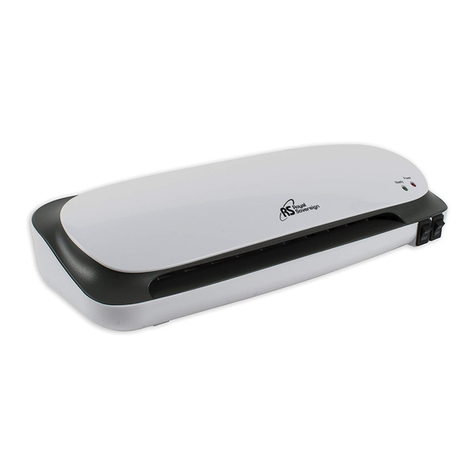
Royal Sovereign
Royal Sovereign CS-923 owner's manual

Neschen
Neschen PHOTOLAM 650 User instructions
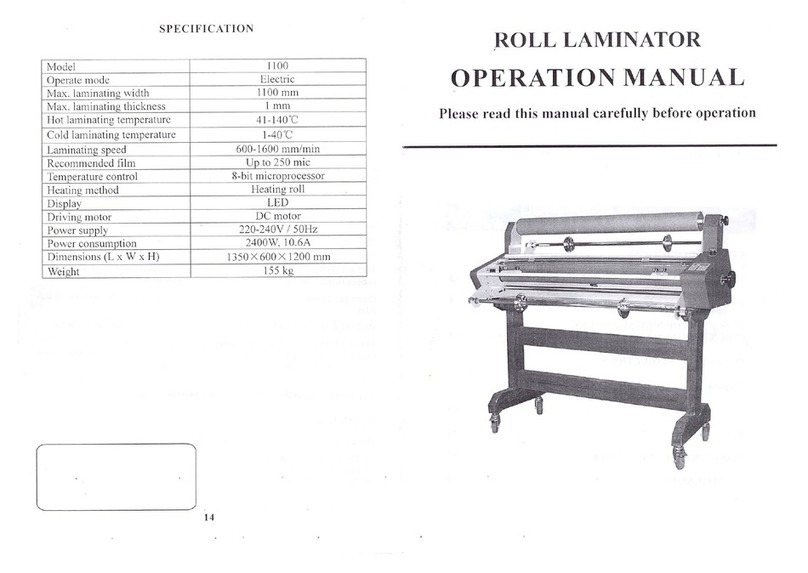
Linea
Linea DH-1100 Operation manual
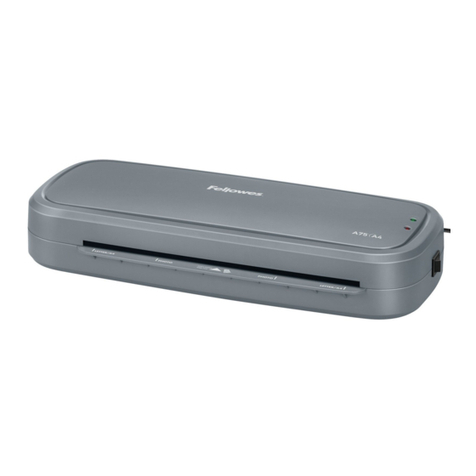
Fellowes
Fellowes A75-A4 instructions

Royal Sovereign International
Royal Sovereign International RSC-1400C owner's manual

Royal Sovereign
Royal Sovereign RSH-1650 Service manual







